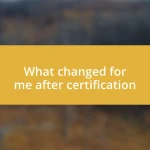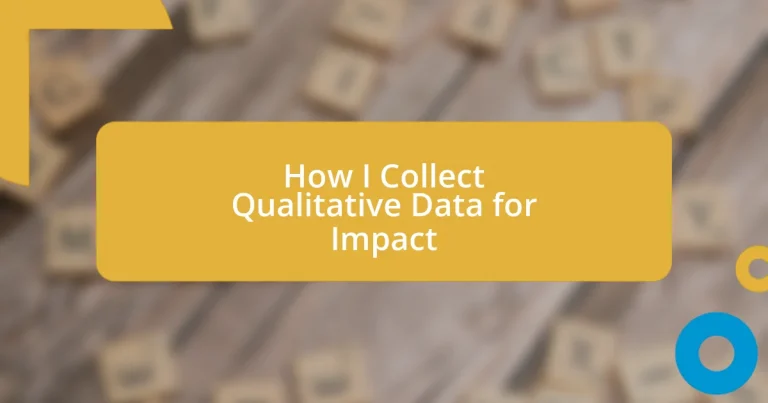Key takeaways:
- Qualitative data collection delves into human experiences, emphasizing the importance of context and personal narratives over mere statistics.
- Choosing effective qualitative methods, such as immersive ethnography and narrative interviews, can yield richer, deeper insights compared to traditional surveys.
- Ethical practices are crucial, including informed consent, awareness of power dynamics, and attending to the emotional impact of sharing personal experiences during research.
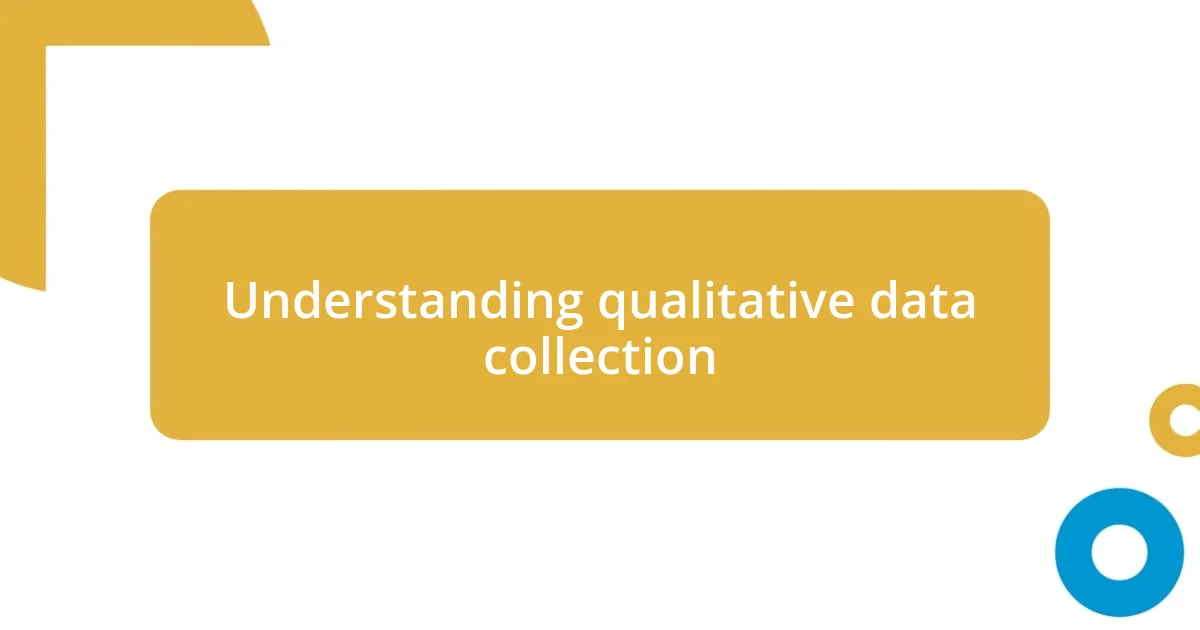
Understanding qualitative data collection
Qualitative data collection is all about diving deep into human experiences, allowing researchers to capture the richness of a situation. For instance, I once conducted interviews in a community struggling with a local issue. The stories I heard were not just statistics; they were emotional narratives that painted a vivid picture of the challenges faced, something numbers alone could never convey.
Have you ever wondered how the emotions behind a decision can shape its outcome? That’s where qualitative data shines. In focus groups, I’ve seen group dynamics spark insights that an individual interview simply wouldn’t reveal. Participants often feed off each other’s energy, unveiling layers of meaning that lead to a profound understanding of their collective feelings and motivations.
Understanding qualitative data also means recognizing the importance of context. I remember a project where a simple observation of daily routines dramatically shifted our approach. It wasn’t just about what people said; it was about how they lived those experiences. This illustrates that qualitative data isn’t just collected — it’s an evolving, nuanced dialogue that invites you to see the world through others’ eyes.
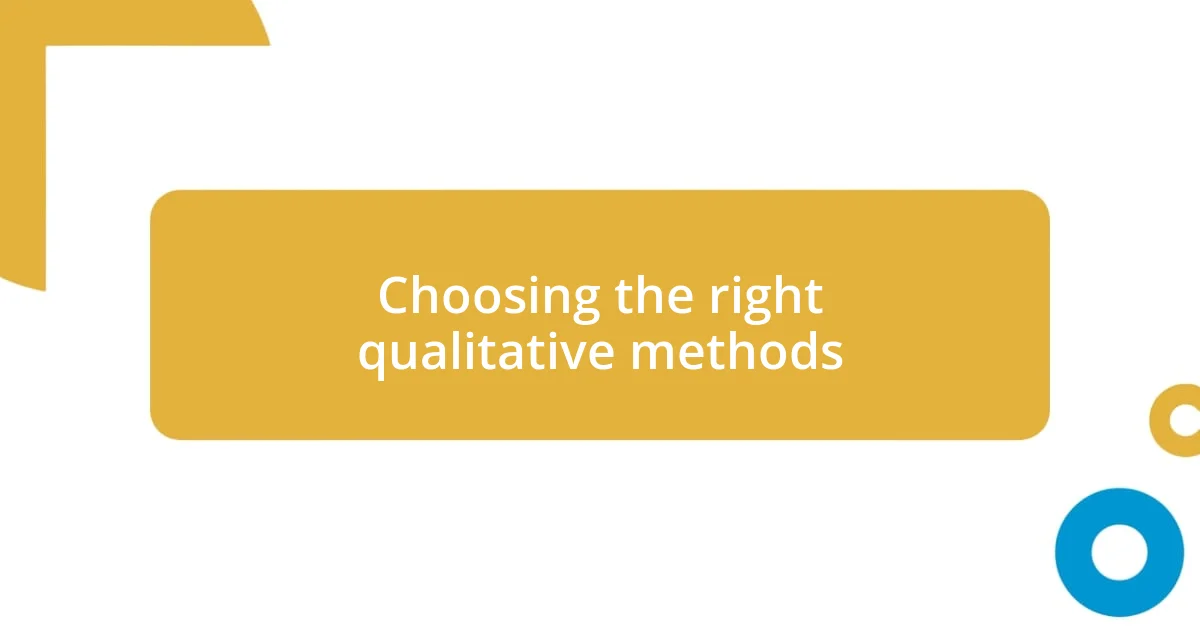
Choosing the right qualitative methods
Choosing the right qualitative methods is crucial for any research project. Based on my experience, the context and objectives determine which method to implement. For instance, in a study involving marginalized communities, I found that participatory methods, which actively engage participants in the research process, led to richer data than traditional surveys.
When selecting a qualitative method, consider how you want to interact with your subjects. I recall a project where I opted for immersive ethnographic research. Living alongside my subjects allowed me to capture nuances that a simple questionnaire could never uncover. This method provided an organic understanding of their world, offering insights that statistical data would simply miss.
Additionally, each method has its unique strengths. For example, I often leverage narrative interviews when I aim to delve into personal stories and emotional depths. These conversations have revealed unexpected insights, demonstrating the power of individual narratives in shaping larger trends and patterns within a community.
| Qualitative Method | Strengths |
|---|---|
| Interviews | Deep personal insights |
| Focus Groups | Dynamic group interactions |
| Ethnography | Immersive context understanding |
| Narrative Analysis | Rich storytelling and emotional depth |
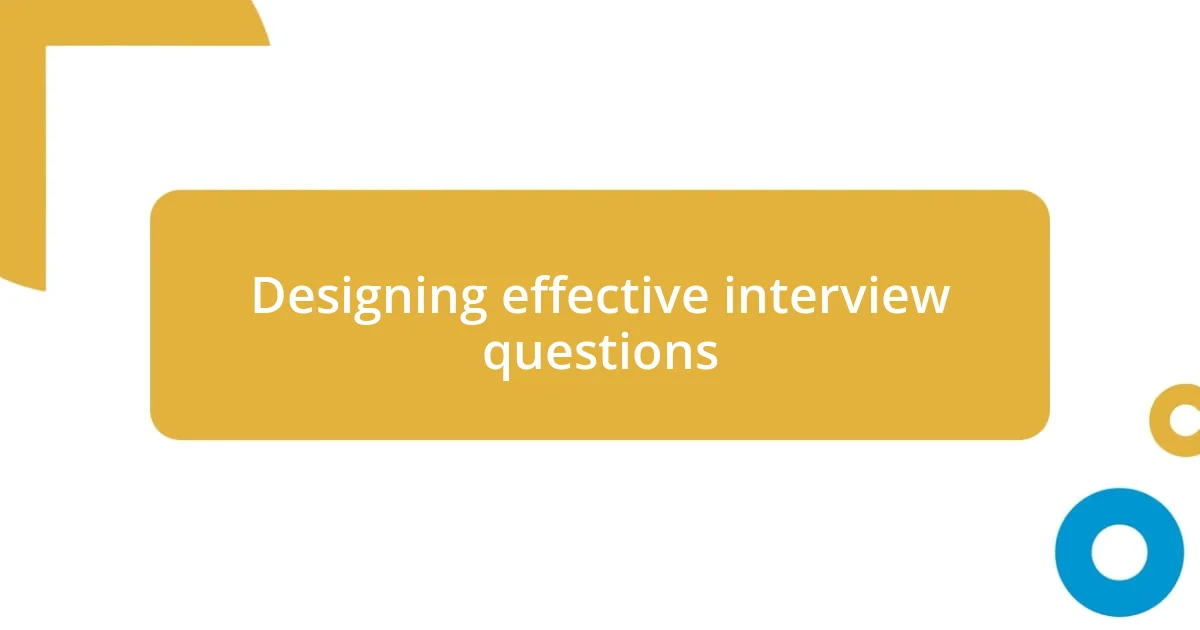
Designing effective interview questions
Designing effective interview questions is an art that takes practice and careful thought. From my interactions, I’ve learned that open-ended questions often spark more genuine dialogue. For example, instead of asking, “Did you like the program?” I might ask, “What was your experience with the program like?” This approach invites the participant to share their narrative, without the constraints of a simple yes or no.
Here are some tips to keep in mind while crafting your questions:
- Be specific: Tailor questions to the context of the interview. Specificity helps in eliciting detailed responses.
- Use open-ended formats: Encourage participants to elaborate on their thoughts and feelings.
- Avoid leading questions: Questions should be neutral to prevent steering participants toward a particular response.
- Pilot your questions: Test them out on a small group to gauge their effectiveness and make adjustments as necessary.
In a project where I was gathering insights on mental health services, I once rephrased a question during the interview, asking, “Can you describe a moment that made you feel supported?” This pivot led to a powerful story about community connection, illustrating how even a small shift can unlock deeper truths. Emphasizing personal experiences reaffirms the importance of reflective questioning and makes the conversation flow more naturally.
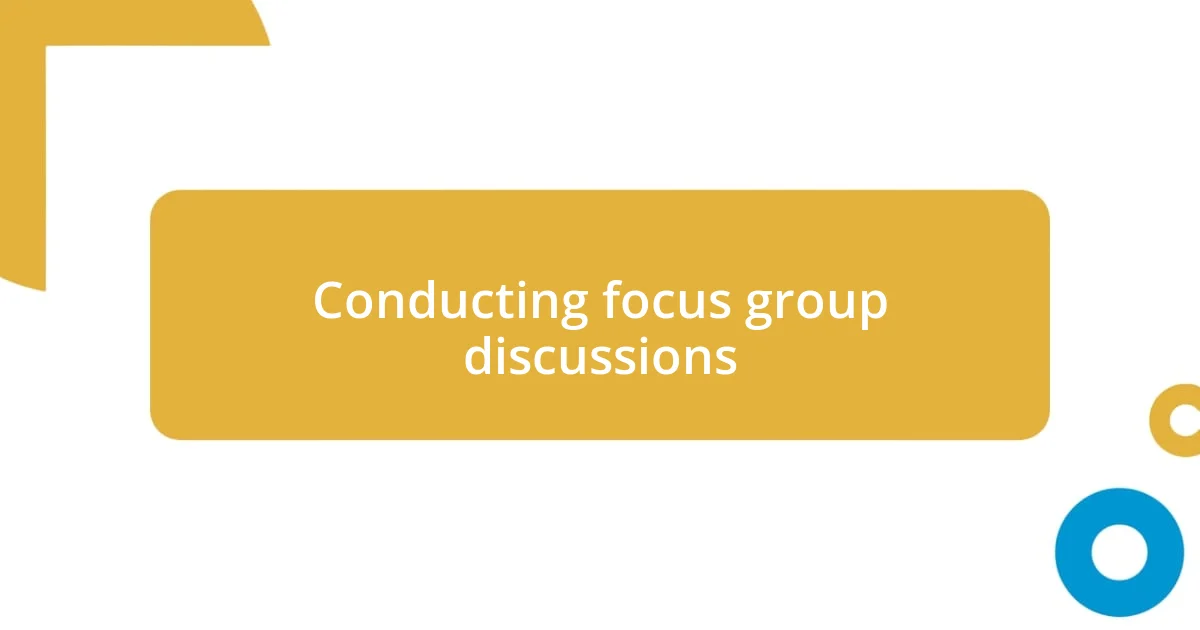
Conducting focus group discussions
Conducting focus group discussions can be a transformative way to gather qualitative data. I once facilitated a focus group with a diverse group of participants discussing a community health initiative. Watching the dynamics unfold was fascinating; the interplay of voices and ideas revealed a wealth of perspectives that I hadn’t anticipated. Have you ever witnessed how one person’s experience can prompt others to share their own stories? It’s remarkable how this collective environment can unlock deeper insights.
I always start by creating a comfortable atmosphere. In one session, I made it a point to establish ground rules emphasizing respect and openness. This made all the difference. Participants felt free to share their thoughts without fear of judgment. I find that when individuals feel safe, their willingness to engage fully can lead to incredibly rich discussions. Adding prompts to steer the conversation, while still allowing organic flow, struck a perfect balance.
Listening actively is essential in focus groups. While gathering insights for a new product launch, I found that my responses could shape the dialogue. Instead of focusing solely on my questions, I leaned into their comments and followed the threads they introduced. It often turned out that some of the most valuable insights emerged not from my prompts but from the spontaneous conversations sparked among participants. Isn’t it fascinating how dialogue can evolve and illuminate new areas of interest we might not have considered?
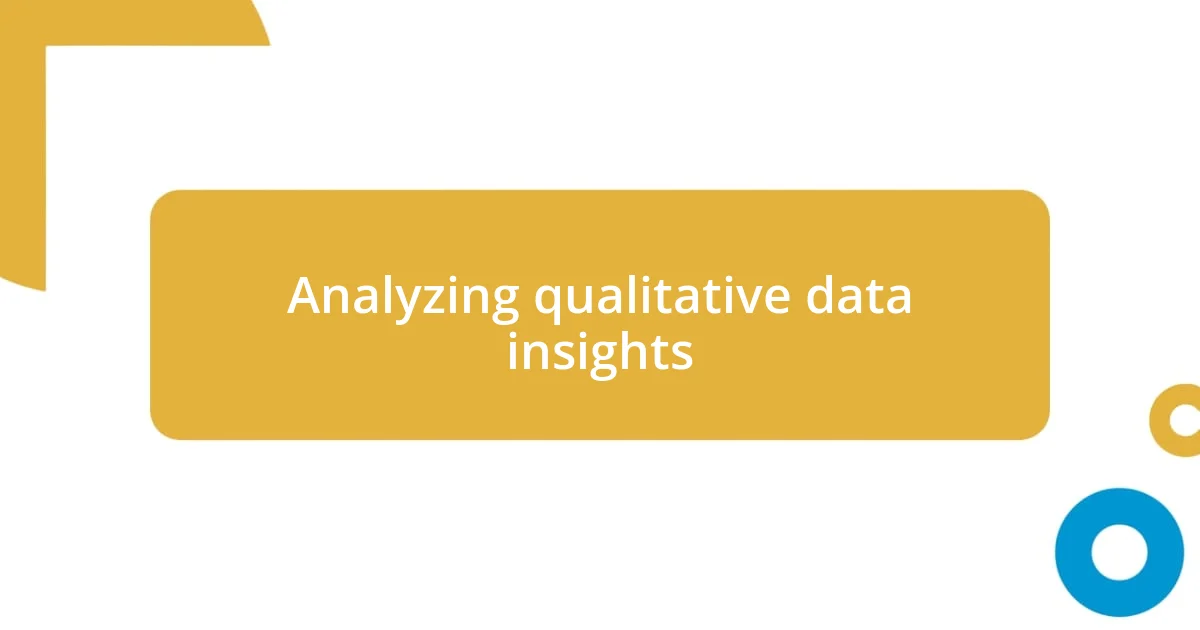
Analyzing qualitative data insights
When it comes to analyzing qualitative data insights, I find that thematic analysis often provides clarity. After collecting interviews for a project on educational equity, I sat down with all the transcripts and color-coded recurring themes. Each color represented different categories, like “barriers to access” and “supportive networks.” Watching the themes emerge felt like piecing together a puzzle, revealing the intricate stories behind the data. How often do we overlook the patterns hiding in plain sight?
Another approach that I cherish is the narrative analysis method. It allows the stories told by participants to take center stage. While reviewing interviews about a local arts program, I focused on individual narratives and noted how they connected to broader community themes. One participant’s journey through creativity encapsulated the essence of shared experiences. For me, it became a transformative moment when data transformed into relatable human experiences. Hasn’t storytelling always been at the heart of understanding each other?
Finally, reflecting on the emotional tones in qualitative data can lead to surprising insights. In a series of interviews discussing mental health challenges, I employed a technique that involved not just analyzing words but paying attention to pauses and emotions. I recorded instances where participants suddenly grew quiet or passionate, which prompted deeper investigation into underlying feelings. It’s incredible how emotions can reveal truths that words alone might mask. How often have you noticed the power of emotions in conversations, making those moments resonate long after they’ve ended?
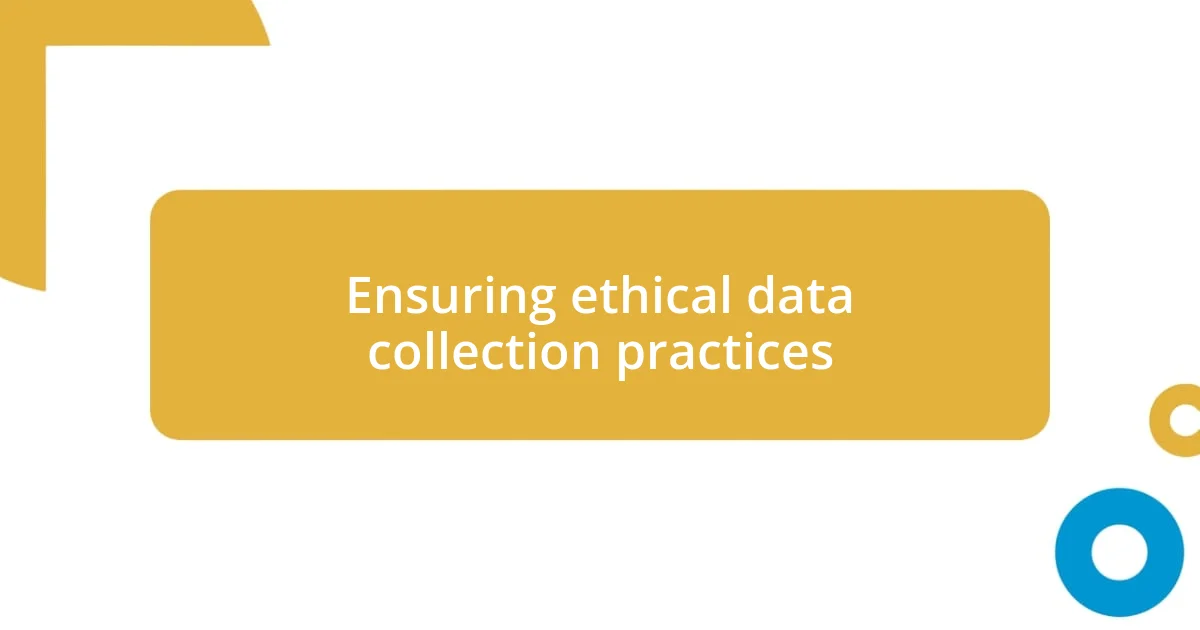
Ensuring ethical data collection practices
Ensuring ethical data collection practices is paramount in my work. I’ve always made it a priority to seek informed consent from participants, ensuring they fully understand how their data will be used. I remember a workshop where one participant initially hesitated to share her story due to concerns about privacy. Once I explained our commitment to confidentiality and how their insights would be anonymized, she felt at ease. It reinforced for me how transparency builds trust, encouraging more open and honest dialogue.
Another crucial aspect is being mindful of power dynamics within the group. I’ve found that when engaging with vulnerable populations, it’s essential to create an equitable discussion space. For instance, during a community needs assessment, I noticed that some individuals were hesitant to voice their opinions, possibly feeling overshadowed by louder voices. By consciously inviting quieter participants to share their thoughts, I witnessed a shift in the room—everyone’s stories mattered, and their contributions enriched our understanding significantly. Have you ever felt the weight of unspoken words in a conversation?
Moreover, I always pay attention to the potential impact of my research on participants. While conducting a study on housing challenges, I regularly reflected on the emotional toll sharing such difficult experiences might have on individuals. To mitigate this, I offered follow-up support resources and encouraged participants to take breaks if they felt overwhelmed. It’s important for me to remember that behind every data point is a real person with feelings and experiences. How often do we forget the humanity that lies within our research?
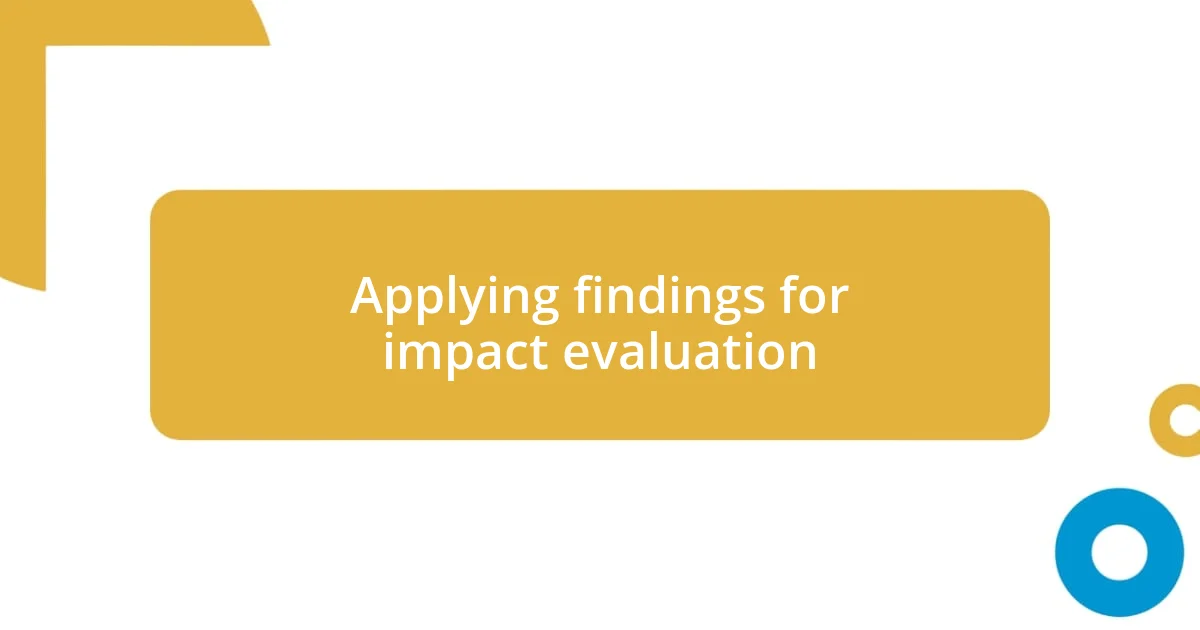
Applying findings for impact evaluation
When applying findings for impact evaluation, I often revisit the participant narratives to ensure the insights translate into actionable change. For instance, after analyzing data from focus groups on public transportation accessibility, I developed recommendations that were not only data-driven but also articulated in the language of the participants. Their voices became the cornerstone of the recommendations, and I felt a deep sense of responsibility to honor their experiences. How can we disregard the power of lived experiences when shaping policy?
I also find that collaboration with stakeholders is crucial for effective application. After gathering data from community interviews about youth engagement programs, I brought together service providers to discuss the findings. This collaborative approach not only encouraged ownership of the insights but also sparked innovative ideas on how to implement changes in real time. Have you ever seen how collective brainstorming can elevate ideas to new heights?
Moreover, it’s essential to track the changes resulting from implemented recommendations. In one instance, I partnered with a school district to assess the impact of newly introduced mental health resources. By revisiting the same schools six months later, I could capture how perceptions and experiences shifted. It was rewarding to witness how qualitative data could drive meaningful improvements in students’ well-being. Aren’t we all looking for that tangible proof that our efforts are making a difference?









